There are 13 species of turtles in Maine and along the coast. There are 8 native species roaming in the Pine Tree State, one non-native species, and 4 varieties of sea turtle species that occasionally appear in nearby coastal waters. The most common species native to Maine are Painted turtles, Snapping turtles, and Musk turtles.
Around the world, turtle populations are in decline in one way or another. Here in Maine, there are a few native threatened species including Blanding’s turtles and Wood turtles.
Turtles are very important to ecological systems here in the United States. At 62 separate species, we have more different types of turtles here than in any other country in the world. So, it’s vitally important to be aware of them, even if you never see any while you are outside.
Here’s our guide to the native turtles in Maine.
Table of Contents
Turtles in Maine
1. Blanding’s Turtle

- Experience Level: Intermediate
- Family: Emydidae
- Scientific Name: Emydoidea blandingii
- Other Names: N/A
- Adult Size: 5 to 8 inches (12.5 to 20 cm)
- Life Span: Up to 80 years
- Average Price Range: $300 to $450
- Conservation Status: Endangered
Named after naturalist William Blanding, these turtles have dark oval shells with faint yellow speckling. Their plastrons (bottom part of the shell) are yellow with black patches, but the most striking feature is the wide swath of bright yellow under their chin and neck.
Blanding’s turtles are often known as the “turtle that smiles”. This is because of the shape of their mouth and the yellow underside. When looking at the front of these turtles, it appears that they are smiling.
These cute turtles prefer wetlands and other areas with shallow, clean water. They are semi-aquatic and spend plenty of time wandering on land. They have been known to wander nearly a mile away from their home habitat.
They will travel quite a distance in the search for mates, a new habitat, or food. Blanding’s turtles are omnivores and will feed on fish, crayfish, frogs, carrion, vegetation, berries, and other food sources.
Blanding’s turtles are quite unique as they rarely show signs of aging. They can still mate well into their 80s and possibly longer. It’s difficult to study such a long lived animal.
Blanding’s turtles are an endangered species in Maine because of declining water cleanliness, poaching, human encroachment, and roadway mortality. These turtles wander around frequently, and often don’t make it across roads. Be alert, and cautious when driving along Maine’s roads.
Box turtles in Maine
2. Eastern Box Turtle

- Experience Level: Beginner
- Family: Emydidae
- Scientific Name: Terrapene carolina carolina
- Other Names: Land Turtle
- Adult Size: 4 to 7 inches
- Life Span: 50 to 100 years
- Average Price Range: $260 – $360
- Conservation Status: Michigan, New Hampshire, Massachusetts, and Connecticut—list the animal as a species of special concern, and Maine lists the turtle as endangered.
Eastern Box turtles are another species native to Maine that’s listed as endangered in the state. These turtles are mainly terrestrial, but will occasionally enter the water to cool off or search for food.
Box turtles have a double hinged plastron that can close up and create a tight seal. This adaptation helps them survive attacks from predators such as raccoons, dogs, skunks, and others.
The carapace (upper shell) has distinct yellow, orange, or reddish markings on the high-domed dark brown shells. Their plastrons are tan or pale yellow with various amounts of black or dark brown.
Eastern Box turtles are mostly found in damp forests and woodlands near sources of water. They need a humid environment, and will sometimes burrow into the damp ground and under leaf litter if they get too dry.
These terrestrial turtles can roam hundreds of yards in a day in search of food. Eastern Box turtles are omnivores and will eat fish, worms, insects, mollusks, fungi, carrion, and seeds and berries.
Musk turtles in Maine
3. Eastern Musk Turtle
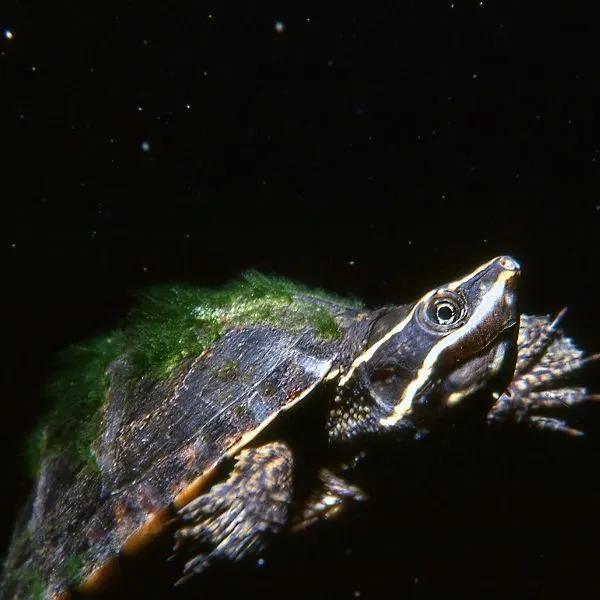
- Experience Level: Intermediate
- Family: Kinosternidae
- Scientific Name: Sternotherus odoratus
- Other Names: Common Musk turtle, Stinkpot
- Adult Size: 4 to 5 inches (10 to 12.5 cm)
- Life Span: 30 to 50 years
- Average Price Range: $30 to $120
- Conservation Status: Least concern
Eastern Musk turtles or Common Musk turtles are also known as “Stinkpots” due to the strong smell they can release from their musk glands. When they are threatened, or a predator tries to make lunch out of Musk turtles they will release their stink. Be careful if you try to handle these little turtles, they can also be quite aggressive, and won’t hesitate to bite.
Eastern Musk turtles have dark, unmarked shells and dark brown, olive, or black skin. They look very similar to other musk and mud turtles except for the pairs of stripes that start at their pointed snout and run behind their heads.
Shallow marshy and boggy habitats with a lot of vegetation are where you’ll find these turtles. Common Musk turtles are not the greatest swimmers, but they can climb well. They use vegetation to hunt, climb, and get to the surface for air.
Musk turtles can also climb trees, sometimes up to 6 feet high, especially if branches reach into the water.
An omnivorous and mainly nocturnal species, Eastern Musk turtles hunt for prey by scent. Favorite foods include snails, crayfish, insects, small fish, algae, and tadpoles.
Snapping turtles in Maine
4. Common Snapping Turtle

- Experience level: Intermediate to Expert
- Family: Chelydrida
- Scientific Name: Chelydra Serpentina
- Other Names: Snapping Turtle, Snapper, Eastern Snapping Turtle
- Average Adult Size: 8 to 20 inches
- Life Span: 30 – 50 years
- Average Price Range: Approximately $40 to $120
- Conservation Status: Least concern
The largest freshwater turtles native to Maine, Common Snappers can be found around nearly any type of water. Habitats range from large, slow moving, heavily vegetated lakes, to shallow marshes, and estuaries.
While this large turtle is in the water, it’s docile and reclusive. You could be inches away from one and never know it.
Once they are settled in a muddy spot, they prefer not to leave it. They don’t even bask very often, but in cooler areas such as Maine, they may be seen on banks or partly submerged logs.
On land, they can be quite aggressive if they are cornered or feel threatened. Snappers will hiss and draw their head in as far as they will go. Then, if you continue to get too close, they can strike out as fast as lightning.
You can identify a Snapping turtle by its thick, ridged shell, and oversized, muscular legs, neck, long tail, and broad head. Their shell is usually black or dark brown but can have a greenish tint because of algae that often grows on it.
Their skin can range from pale yellow to dark brown or black. The tail is quite long and has bony, saw-toothed ridges.
Common Snapping turtles are omnivores but prefer meat such as fish, amphibians, crayfish, smaller turtles, and the occasional water bird if they get close. While they have a bad reputation for eating ducklings and other waterfowl, in reality, Snapping turtles rarely take down birds.
Painted turtles in Maine
5. Eastern Painted Turtle

- Experience level: Beginner
- Family: Emydidae
- Scientific Name: Chrysemys picta
- Common Name: Painted Turtle
- Average Adult Size: 4 – 10 inches
- Life Span: 30 – 50 years
- Average Price Range: Between $30 to $150
- Conservation Status: Least Concern
Painted turtles are the most widespread species of turtles found in North America. There are 4 recognized subspecies of painted turtles.
Eastern Painted turtles have a smooth, slightly domed carapace that’s dark green and darkens over time. They have yellow or white stripes all along their skin. Their plastron ranges from yellow, tan, to orange and usually has no markings at all. There are a few exceptions that have some dark smudges on their plastron.
The Eastern Painted turtle is often found in slow-moving waters such as rivers, streams, ponds, and lakes. Since they need a lot of warmth to move, feed, and digest their food, painted turtles are often seen basking on banks, logs, or outcroppings.
Adult Painted turtles are omnivorous, but they tend to eat more vegetation than insects, crayfish, fish, and mollusks. Juveniles are more meat eating turtles as they require more protein in their diet.
6. Midland Painted Turtle

- Experience Level: Beginner
- Family: Emydidae
- Scientific Name: Chrysemys picta marginata
- Other Names: N/A
- Adult Size: Between 4 and 10 inches
- Life Span: Between 30 and 50 years
- Average price range: Between $30 and $150
- Conservation Status: Special concern
Midland Painted turtles look very similar to their Eastern cousins. These turtles have a similar carapace and yellow or white stripes on their extremities. The differences between the two include red stripes on the Midland Painted turtle’s legs and an orange or yellow plastron with a midline pattern.
These turtles prefer the same watery habitat, and they often overlap and can be seen basking together. They like shallow waters, plenty of places to warm up in the sun, and a lot of aquatic vegetation.
Midland Painted turtles are aquatic omnivores. They eat a wide variety of vegetation, fish, mollusks, and insects.
Spotted Turtles in Maine
7. Spotted Turtle

- Experience Level: Intermediate to Expert
- Family: Emydidae
- Scientific Name: Clemmys guttata
- Other Names: Polka-dot turtle, “Spotty”
- Adult Size: 4 to 5 inches
- Life Span: Males up to 65 years; females up to 110 years
- Average Price Range: $200 to $300
- Conservation Status: Endangered
Spotted turtles are a small, beautiful species. Their smooth, domed shells are black, and covered with their eponymous bright yellow dots. The number of spots varies widely from turtle to turtle. Some have as few as 1 or 2, while others can be covered with over 100 spots.
Their plastrons are tan or cream colored with large black patches of varying sizes on each of the scutes (shell plates or sections). Their skin is the same color as their carapace and has yellow spots and patterns.
Preferred habitats for the Spotted turtle include swamps, bogs, marshes, and woodland streams. Though they spend time in the water, the Spotty also wanders along the land, sometimes for long distances.
Spotted turtles can shed their scutes and often have very smooth shells. Another amazing characteristic of these turtles is their intelligence. Scientists have determined that Spotted turtles, along with Wood turtles are as smart as mice.
If you’re unaware of how intelligent a mouse is, some people say mice are as smart as toddlers, and maybe more so.
Spotted turtles are very sensitive to water quality, as more waters become polluted, their numbers decline.
They are omnivorous and will eat vegetation such as duckweed, and invertebrates such as insects, mollusks, and small crustaceans.
Wood Turtles in Maine
8. Wood Turtle
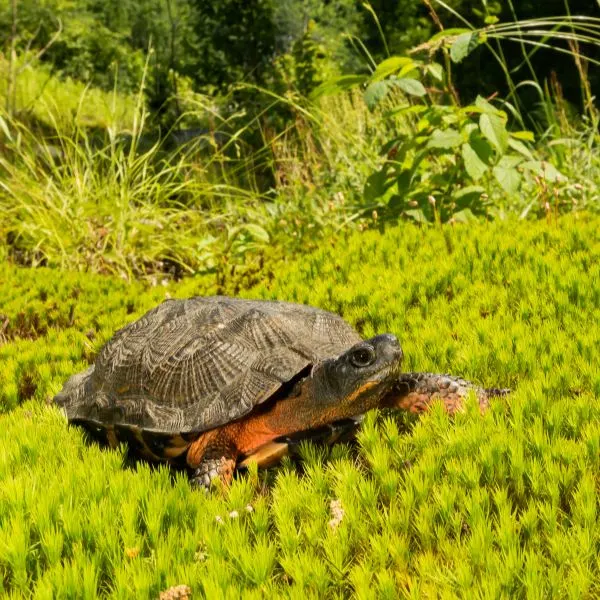
- Experience Level: Intermediate
- Family: Emydidae
- Scientific Name: Glyptemys insculpta
- Other Names: N/A
- Adult Size: 5.5 to 9 inches
- Life Span: 40 to 60 years
- Average Price Range: $250 to $500
- Conservation Status: Endangered
Wood turtles are another species of intelligent reptile. These turtles have even figured out how to trick worms into emerging from the safety of the ground.
Wood turtles will do a little “dance” and stomp the ground. Earthworms think it’s raining, and instead of staying in the ground and drowning, they rise to the surface, where the Wood turtle is waiting to gobble them up.
Because these turtles are so attractive looking to collectors, many of them get taken from the wild illegally. This poaching adversely affects their numbers because they are very slow to reproduce.
Other problems that affect this turtle population include human encroachment, road mortality, and pollution.
Wood turtles are named so because of their carapace. It often looks like carved wood, complete with ridges that look like wood growth rings. Their skin is dark brown to black with yellow, orange, or red coloration on the lower limbs.
Wood turtles are semi-aquatic and often inhabit wooded plains, meadows, marshes, fields, and farmland. The main requirement is a water source such as a pond, marsh, or shallow stream. Wood turtles don’t require water to swallow their food but they use water to cool off and sometimes to hunt for food.
These turtles are omnivorous and will eat berries, carrion, fish, worms, insects, and even small mice on occasion.
Pond sliders in Maine
9. Red Eared Slider
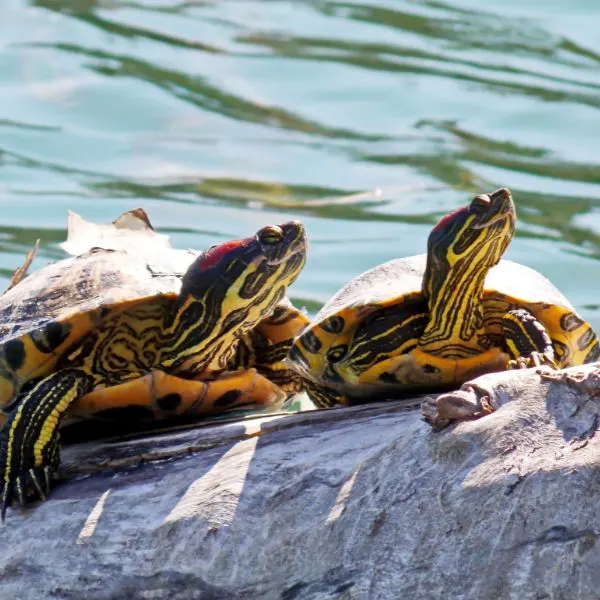
- Experience level: Beginner
- Family: Emydidae
- Scientific Name: Trachemys scripta elegans
- Common Name: Pond slider, Red-eared terrapin, Water slider
- Average Adult Size: 6 – 8 inches
- Life Span: 20 to 40 years
- Average Price Range: approximately $30 to $100
- Conservation Status: Least concern
Red Eared Sliders are an introduced and invasive species in Maine. They don’t naturally occur in the Pine Tree State and were possibly released by previous owners.
These medium sized turtles are extremely adaptive and can even survive the harsh winters in Maine. They prefer slow moving waters of lakes, reservoirs, rivers, and ponds, but they will tolerate nearly any kind of fresh water.
Red Eared sliders start off with a very ornate, multi-colored carapace and a yellow plastron with dark spots. Their skin is dark green and has yellow to white stripes much like painted turtles. The main distinguishing characteristic is the red ovate mark behind their eyes.
Over time though, these colors fade, especially the carapace which can darken to nearly all black. Some owners don’t expect this and find that their beautiful turtle is now drab and they don’t want it.
Thinking the turtle would be happier in the wild, they release them into nearby waters. Here the Red Eared Sliders can quickly take over and upset native turtle populations.
Red Eared Sliders are aggressive toward other species of turtles. Some people have even seen these plucky turtles taking on and harming Common Snapping turtles!
Because of their invasive and aggressive habits, it is illegal to own, trade, or sell these turtles in the state of Maine.
Sea Turtles In Maine
Of the 6 different species of sea turtles around the world, 4 can often be seen off the coast of Maine. These include the Ridley Sea turtle, Atlantic Leatherback, Green Sea turtle, and the Loggerhead Sea turtle. All species of sea turtles are endangered and highly protected so they cannot be kept as pets. Here are some facts about these amazing marine species.
10. Atlantic Leatherback Sea Turtle
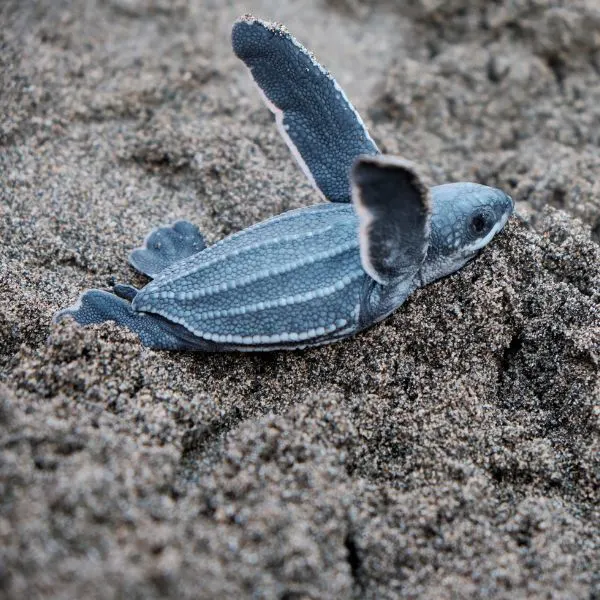
- Experience level: N/A, Illegal to own any sea turtle
- Family: Dermochelyidae
- Scientific Name: Dermochelys coriacea
- Other Names: Atlantic Leatherback, Leatherback
- Average Adult Size: 4 – 8 ft
- Life Span: 30 – 50 years
- Average Price Range: N/A
- Conservation Status: Endangered
The Leatherback Sea turtle is the largest of the sea turtles and the largest turtle in the world. They also have the distinction of not having a hard shell, being the turtle that can dive the deepest, and being the most migratory. They have been known to travel over 10,000 miles in one year.
Indeed, these massive turtles are record-breaking overachievers. In addition, these turtles can be found in exceptionally cold waters that all other sea turtles avoid.
Aside from their massive bulk, these turtles have long front flippers and dark, purplish-black skin with white spots. They have seven ridges that run from the front of their leathery carapace to their tail.
The Atlantic Leatherback eats mainly jellyfish. They follow migrating populations of massive lion’s mane jellyfish and keep their numbers in check.
11. Green Sea Turtle

- Experience level: N/A, Illegal to own any sea turtle
- Family: Cheloniidae
- Scientific Name: Chelonia mydas
- Other Names: Green Sea Turtle
- Average Adult Size: 3 – 4 feet
- Life Span: 50 – 70 years
- Average Price Range: N/A
- Conservation Status: Endangered
Green Sea turtles are not just green, they are white, black, brown, and many other colors in between. They are called green because their fat and other internal organs are green. These organs get this coloration because of the algae and seagrass that these turtles feed on.
These turtles like to stay around shallow reefs where they can spend their day grazing on algae and vegetation.
Sea turtles are all endangered because of hunting, getting caught in fishing nets, coastal nesting ground development, and collisions with boats.
If you ever visit beaches where turtles nest, you’ll probably see a lot of signs asking people to turn off lights after a certain time. This is because turtles use the reflection of the moon off the water to navigate at night.
When sea turtles see all the lights from coastal properties, they either get confused or are too frightened to come ashore and nest.
12. Loggerhead Sea Turtle
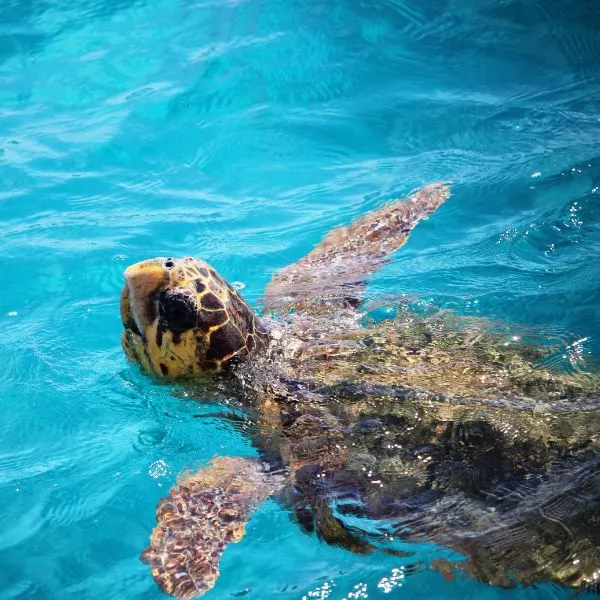
- Experience Level: N/A, Illegal to own any sea turtle
- Family: Cheloniidae
- Scientific Name: Caretta Caretta
- Other Names: Loggerhead
- Adult Size: 2.5 – 3.5 feet
- Life Span: 70 – 80 years
- Average Price Range: N/A
- Conservation Status: Endangered
The Loggerhead Sea turtle is the largest hard-shelled turtle in the world. It also has a very large head in relation to the rest of its body. They have such big heads to house very strong jaw muscles.
These knots of muscle, in addition to broad, crushing jaws, allow the Loggerhead turtle to easily break through tough shells of conch, whelks, lobsters, crabs, and horseshoe crabs.
Adults can weigh nearly 300 pounds. Their shell has raised points running down the middle, but these ridges smooth out over time.
These turtles are often found in temperate and subtropical waters, but you can occasionally spot them off Maine’s coast.
Though all sea turtles are endangered, the Loggerhead is the most abundant species. This is due in part to strict regulations regarding turtles and their nests. It’s also because of the tireless efforts of biologists and tons of volunteers.
13. Kemp’s Ridley Sea Turtle
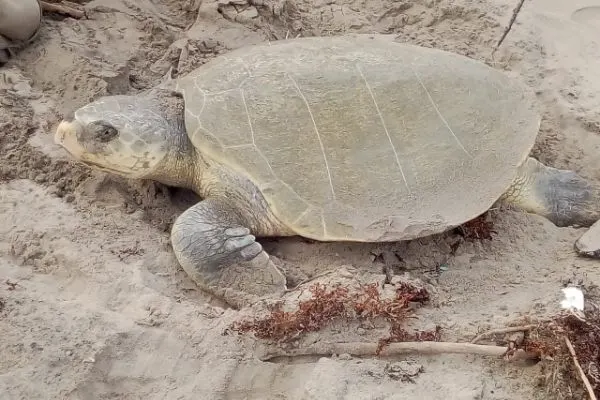
- Experience level: N/A, Illegal to own any sea turtle
- Family: Cheloniidae
- Scientific Name: Lepidochelys kempii
- Other Names: Atlantic Ridley, Tortuga Lora (Mexico)
- Average Adult Size: 24 – 27 inches
- Life Span: 30 years
- Average Price Range: N/A
- Conservation Status: Critically endangered
Kemp’s Ridley Sea turtles are the smallest species and the most endangered of all the sea turtles. These turtles are only found in the Gulf of Mexico and along the Atlantic Ocean coast.
One reason these turtles are so endangered is because they engage in arribada. This term means that groups of female turtles will gather offshore and then all of them will come ashore at the same time to nest all at once.
These and the Olive Ridley Sea turtles are the only species to do this; they both also only nest during daylight. While this mass nesting behavior helps more turtles survive natural predators such as gulls, crabs, and fish, humans have figured out how to exploit this.
Sea turtle eggs are harvested for food in some areas. When the nests are dug up, this drastically reduces the number of baby sea turtles that make it to the water.
Did you know that only about 1 out of every 1,000 sea turtle babies make it to adulthood?
Kemp’s Ridley Sea turtles mainly feed on crabs and other crustaceans. They will also eat jellyfish, sea stars (watch out Patrick!), shrimp, clams, and fish when they can catch them.
Wrapping up
There are all the turtles you may find in the state and around Maine’s coastal waters. There are several species in Maine ranging from terrestrial Eastern Box turtles to aquatic and common Painted turtles.
Turtles need our help, so while you’re out in Maine’s wilderness, be mindful of turtles and clean up after yourself. If you see wild turtles, take pictures, not the turtle. If you want a pet, locate a reputable breeder, and do your research. Turtles are exceptionally cute, but they are a lifetime commitment.
Did you enjoy this article? Feel free to comment below about turtles you’ve seen or owned! We love hearing from our readers!
Other nearby states
